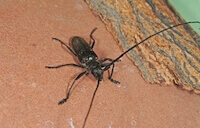WHAT DO longhorn BEETLES LOOK LIKE

Adult longhorn beetles are varied in color and texture. They also vary in size – ranging from 3/4 inch to over 1-1/2 inches long. However, there is one attribute that they all have in common, and that is very long antennae (thus the name), although some are not as impressive as others. Longhorn beetles are a large group of insects belonging to the family Cerambycidae. The larvae spend their time in the wood they attack and leave round exit holes in the bark of a tree. You will often see excessive sawdust (frass) buildup near tree bases or unseasonable yellowed or drooping leaves when longhorn beetles are present.